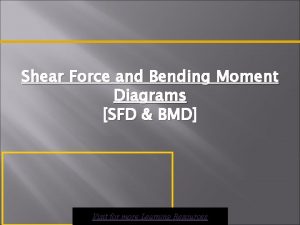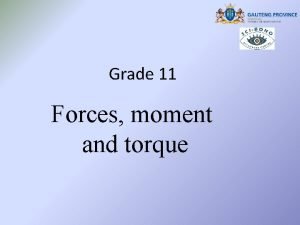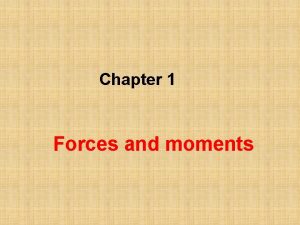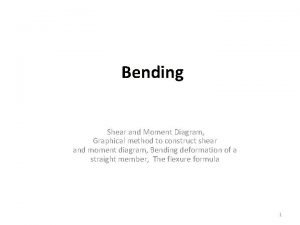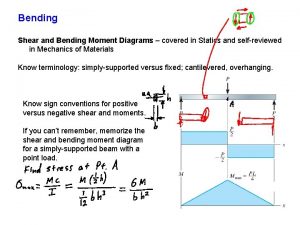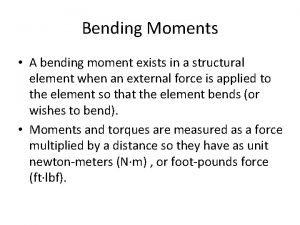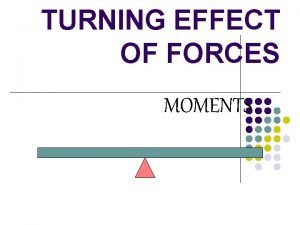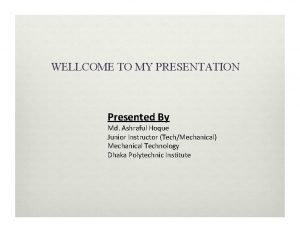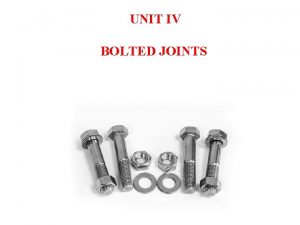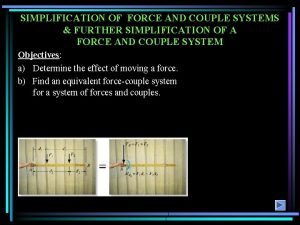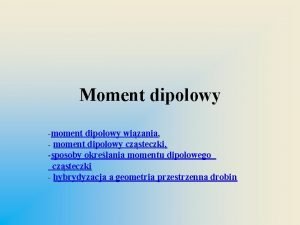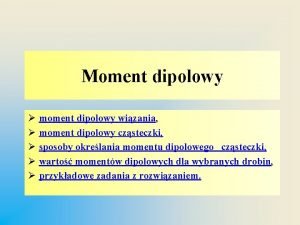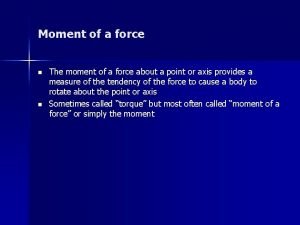38 Chapter 2 Force Systems 24 Moment In












- Slides: 12

38 Chapter 2 Force Systems 2/4 Moment In addition to the tendency to move a body in the direction of its application, a force can also tend to rotate a body about an axis. The axis may be any line which neither intersects nor is parallel to the line of action of the force. This rotational tendency is known as the moment M of the force. Moment is also referred to as torque. As a familiar example of the concept of moment, consider the pipe wrench of Fig. 2/8 a. One effect of the force applied perpendicular to the handle of the wrench is the tendency to rotate the pipe about its vertical axis. The magnitude of this tendency depends on both the magnitude F of the force and the effective length d of the wrench handle. Common experience shows that a pull which is not perpendicular to the wrench handle is less effective than the right-angle pull shown. d F Moment about a Point Figure 2/8 b shows a two-dimensional body acted on by a force F in its plane. The magnitude of the moment or tendency of the force to rotate the body about the axis O-O perpendicular to the plane of the body is proportional both to the magnitude of the force and to the moment arm d, which is the perpendicular distance from the axis to the line of action of the force. Therefore, the magnitude of the moment is defined as (a) O M F α r A M = Fd d (b) O M (c) y F + x M = Fd A d (d) Figure 2/8 (2/5) The moment is a vector M perpendicular to the plane of the body. The sense of M depends on the direction in which F tends to rotate the body. The right-hand rule, Fig. 2/8 c, is used to identify this sense. We represent the moment of F about O-O as a vector pointing in the direction of the thumb, with the fingers curled in the direction of the rotational tendency. The moment M obeys all the rules of vector combination and may be considered a sliding vector with a line of action coinciding with the moment axis. The basic units of moment in SI units are newton-meters (N · m), and in the U. S. customary system are pound-feet (lb-ft). When dealing with forces which all act in a given plane, we customarily speak of the moment about a point. By this we mean the moment with respect to an axis normal to the plane and passing through the point. Thus, the moment of force F about point A in Fig. 2/8 d has the magnitude M = Fd and is counterclockwise. Moment directions may be accounted for by using a stated sign convention, such as a plus sign ( ) for counterclockwise moments and a minus sign (-) for clockwise moments, or vice versa. Sign consistency within a given problem is essential. For the sign convention of Fig. 2/8 d, the moment of F about point A (or about the z-axis passing through point A) is positive. The curved arrow of the figure is a convenient way to represent moments in two-dimensional analysis.

Article 2/4 The Cross Product In some two-dimensional and many of the three-dimensional problems to follow, it is convenient to use a vector approach for moment calculations. The moment of F about point A of Fig. 2/8 b may be represented by the cross-product expression M = r x. F (2/6) where r is a position vector which runs from the moment reference point A to any point on the line of action of F. The magnitude of this expression is given by* M = Fr sin a = Fd (2/7) which agrees with the moment magnitude as given by Eq. 2/5. Note that the moment arm d = r sin a does not depend on the particular point on the line of action of F to which the vector r is directed. We establish the direction and sense of M by applying the right-hand rule to the sequence r x F. If the fingers of the right hand are curled in the direction of rotation from the positive sense of r to the positive sense of F, then the thumb points in the positive sense of M. We must maintain the sequence r x F, because the sequence F x r would produce a vector with a sense opposite to that of the correct moment. As was the case with the scalar approach, the moment M may be thought of as the moment about point A or as the moment about the line O-O which passes through point A and is perpendicular to the plane containing the vectors r and F. When we evaluate the moment of a force about a given point, the choice between using the vector cross product or the scalar expression depends on how the geometry of the problem is specified. If we know or can easily determine the perpendicular distance between the line of action of the force and the moment center, then the scalar approach is generally simpler. If, however, F and r are not perpendicular and are easily expressible in vector notation, then the cross-product expression is often preferable. In Section B of this chapter, we will see how the vector formulation of the moment of a force is especially useful for determining the mo- ment of a force about a point in three-dimensional situations. Varignon’s Theorem One of the most useful principles of mechanics is Varignon’s theorem, which states that the moment of a force about any point is equal to the sum of the moments of the components of the force about the same point. *See item 7 in Art. C/7 of Appendix C for additional information concerning the cross product. Moment 39

40 Chapter 2 Force Systems To prove this theorem, consider the force R acting in the plane of the body shown in Fig. 2/9 a. The forces P and Q represent any two nonrectangular components of R. The moment of R about point O is MO = r x R Because R = P + Q, we may write r x R = r x (P + Q) Using the distributive law for cross products, we have (2/8) MO = r x R = r x P + r x Q which says that the moment of R about O equals the sum of the moments about O of its components P and Q. This proves theorem. Varignon’s theorem need not be restricted to the case of two components, but it applies equally well to three or more. Thus we could have used any number of concurrent components of R in the foregoing proof. * Figure 2/9 b illustrates the usefulness of Varignon’s theorem. The moment of R about point O is Rd. However, if d is more difficult to determine than p and q, we can resolve R into the components P and Q, and compute the moment as MO = Rd = -p. P + q. Q where we take the clockwise moment sense to be positive. Sample Problem 2/5 shows how Varignon’s theorem can help us to calculate moments. P R B B q Q r d O O Q p (b) (a) Figure 2/9 *As originally stated, Varignon’s theorem was limited to the case of two concurrent components of a given force. See The Science of Mechanics, by Ernst Mach, originally published in 1883.

Article 2/4 Moment 41 SAMPLE PROBLEM 2/5 2 m A Calculate the magnitude of the moment about the base point O of the 600 -N force in five different ways. 40° 600 N 4 m Solution. (I) The moment arm to the 600 -N force is 0 d = 4 cos 40° + 2 sin 40° = 4. 35 m 2 m O By M = Fd the moment is clockwise and has the magnitude 40° MO = 600(4. 35) = 2610 N · m (II) Ans. 4 m 600 N 40° d Replace the force by its rectangular components at A, F 1 = 600 cos 40° = 460 N, F 2 = 600 sin 40° = 386 N 0 By Varignon’s theorem, the moment becomes 8 MO = 460(4) + 386(2) = 2610 N · m Ans. (III) By the principle of transmissibility, move the 600 -N force along its line of action to point B, which eliminates the moment of the component F 2. The moment arm of F 1 becomes 4 m F 2 = 600 sin 40° 0 d 1 = 4 + 2 tan 40° = 5. 68 m B y Fl and the moment is F 2 MO = 460(5. 68) = 2610 N · m e Fl = 600 cos 40° 2 m A Ans. (IV) Moving the force to point C eliminates the moment of the component F 1. The moment arm of F 2 becomes dl x F r C d 2 = 2 + 4 cot 40° = 6. 77 m 0 and the moment is 2 Fl F 2 MO = 386(6. 77) = 2610 N · m Ans. Helpful Hints (V) By the vector expression for a moment, and by using the coordinate system indicated on the figure together with the procedures for evaluating cross products, we have 0 d O The required geometry here and in similar problems should not cause difficulty if the sketch is carefully drawn. 8 This MO = r x F = (2 i + 4 j) x 600(i cos 40° -j sin 40°) = -2610 k N · m The minus sign indicates that the vector is in the negative z-direction. The magnitude of the vector expression is MO = 2610 N · m Ans. procedure is frequently the shortest approach. e The fact that points B and C are not on the body proper should not cause concern, as the mathematical calculation of the moment of a force does not require that the force be on the body. 0 Alternative choices for the position vector r are r = d 1 j = 5. 68 j m and r = d 2 i = 6. 77 i m.

42 Chapter 2 Force Systems SAMPLE PROBLEM 2/6 The trap door OA is raised by the cable AB, which passes over the small frictionless guide pulleys at B. The tension everywhere in the cable is T, and this tension applied at A causes a moment MO about the hinge at O. Plot the quantity MO/T as a function of the door elevation angle O over the range 0 O 90° and note min- imum and maximum values. What is the physical significance of this ratio? B T 0. 3 m A 0. 5 m 0. 4 m 0 θ Solution. We begin by constructing a figure which shows the tension force T acting directly on the door, which is shown in an arbitrary angular position O. It should be clear that the direction of T will vary as O varies. In order to deal with this variation, we write a unit vector n. AB which "aims" T: B AB d Using the x-y coordinates of our figure, we can write 8 0 r. OB = 0. 4 j m and r. OA = 0. 5(cos Oi + sin Oj) m T A x O Recall that any unit vector can be r. AB = r. OB -r. OA = 0. 4 j -(0. 5)(cos Oi + sin Oj) = -0. 5 cos Oi + (0. 4 -0. 5 sin O)j m written as a vector divided by its magnitude. In this case the vector in the numerator is a position vector. r. AB = J(0. 5 cos O)2 + (0. 4 -0. 5 sin O)2 0. 5 = J 0. 41 -0. 4 sin O m 0. 4 The desired unit vector is n. AB = r r. AB = -0. 5 cos Oi + (0. 4 -0. 5 sin O)j AB T = Tn. AB = T [ 0. 3 M 0 ——–, J 0. 41 -0. 4 sin O T Our tension vector can now be written as 8 r 0 B r 0 A θ Helpful Hints So and r. AB r. OB - r. OA r. AB n. AB = r = O y m 0. 2 0. 1 -0. 5 cos Oi + (0. 4 -0. 5 sin O)j 0 J 0. 41 -0. 4 sin O 0 10 20 30 40 50 60 70 80 90 θ, deg The moment of T about point O, as a vector, is MO = r. OB x T, where r. OB = 0. 4 j m, or MO = 0. 4 j x T = [ 8 Recall that any vector may be writ- -0. 5 cos Oi + (0. 4 -0. 5 sin O)j ten as a magnitude times an "aiming" unit vector. J 0. 41 -0. 4 sin O 0. 2 T cos k O -0. 4 sin J 0. 41 O 8 In the expression M = r x F, the po- The magnitude of MO is MO = sition vector r runs from the moment center to any point on the line of action of F. Here, r. OB is more convenient than r. OA. 0. 2 T cos O J 0. 41 -0. 4 sin O and the requested ratio is MO 0. 2 cos O = T J 0. 41 -0. 4 sin O Ans. which is plotted in the accompanying graph. The expression MO/T is the moment arm d (in meters) which runs from O to the line of action of T. It has a maximum value of 0. 4 m at O = 53. 1° (at which point T is horizontal) and a minimum value of 0 at O = 90° (at which point T is vertical). The expression is valid even if T varies. This sample problem treats moments in two-dimensional force systems, and it also points out the advantages of carrying out a solution for an arbitrary posi- tion, so that behavior over a range of positions can be examined.

Article 2/4 Problems 43 PROBLEMS Q Introductory Problems 2/31 T P The 4 -k. N force F is applied at point A. Compute the moment of F about point O, expressing it both as a scalar and as a vector quantity. Determine the coordinates of the points on the x- and y-axes about which the moment of F is zero. R 50 mm y, m M O A (1. 2, 1. 5) 3 Problem 2/33 5 F = 4 k. N x, m O 2/34 The force of magnitude F acts along the edge of the triangular plate. Determine the moment of F about point O. b O A Problem 2/31 2/32 The rectangular plate is made up of 1 -ft squares as shown. A 30 -lb force is applied at point A in the direction shown. Calculate the moment MB of the force about point B by at least two different methods. h F 30 lb 1 ft B A Problem 2/34 1 ft 2/35 y Calculate the moment of the 250 -N force on the handle of the monkey wrench about the center of the bolt. 250 N x B 15° 200 mm Problem 2/32 2/33 The throttle-control sector pivots freely at O. If an internal torsional spring exerts a return moment M = 1. 8 N · m on the sector when in the position shown, for design purposes determine the necessary throttle-cable tension T so that the net moment about O is zero. Note that when T is zero, the sector rests against the idle-control adjustment screw at R. 30 mm Problem 2/35

44 Chapter 2 Force Systems 2/36 The tension in cable AB is 100 N. Determine the moment about O of this tension as applied to point A of the T-shaped bar. The dimension b is 600 mm. 20° F = 60 N b– – 2 A O b– – 2 r = 100 mm Problem 2/38 b 60° O B Representative Problems b 2/39 Problem 2/36 2/37 A prybar is used to remove a nail as shown. Determine the moment of the 60 -lb force about the point O of contact between the prybar and the small support block. The slender quarter-circular member of mass m is built-in at its support O. Determine the moment of its weight about point O. Use Table D/3 as necessary to determine the location of the mass center of the body. m 60 lb A b 15° 14″ O Problem 2/39 2/40 65° The 30 -N force P is applied perpendicular to the portion BC of the bent bar. Determine the moment of P about point B and about point A. O P = 30 N 1. 2″ C 1. 6 m Problem 2/37 2/38 A force F of magnitude 60 N is applied to the gear. Determine the moment of F about point O. 45° B 1. 6 m A Problem 2/40

Article 2/4 Problems 45 2/41 Compute the moment of the 0. 4 -lb force about the pivot O of the wall-switch toggle. 2/44 Determine the moments of the tension T about point P and about point O. F = 0. 4 lb T 10° α A θ A 8 _7″ 30° O O r P Problem 2/44 Problem 2/41 2/42 The cable AB carries a tension of 400 N. Determine the moment about O of this tension as applied to point A of the slender bar. B 2/45 The lower lumbar region A of the spine is the part of the spinal column most susceptible to abuse while resisting excessive bending caused by the moment about A of a force F. For given values of F, b, and h, determine the angle O which causes the most severe bending strain. F θ 650 mm A mm 500 h 30° A O b Problem 2/42 Problem 2/45 2/43 As a trailer is towed in the forward direction, the force F = 120 lb is applied as shown to the ball of the trailer hitch. Determine the moment of this force about point O. F = 120 lb 30° 1. 25′′ A O 11′′ Problem 2/43 1. 5′′

46 2/46 Chapter 2 Force Systems Determine tee combined moment about 0 due to tee weiget of tee mailbox and tee cross member AB. Tee mailbox weiges 4 lb and tee uniform cross member weiges 10 lb. Bote weigets act at tee geometric centers of tee respective items. s IN GO D W E TRU S 9. 5 mm LIBERTY 1989 3. 5 mm 1″ 19″ 3″ T O 7″ 20° 7″ 9″ pennies 3. 5″ A B Problem 2/47 2/48 38″ dimes Tee crank of Prob. 2/10 is repeated eere. If 0 A = 50 mm, 0 = 25°, and 3 = 55°, determine tee moment of tee force F of magnitude F = 20 N about point 0. F B β t n y O Problem 2/46 A 2/47 A portion of a meceanical coin sorter works as follows: Pennies and dimes roll down tee 20° incline, tee last triangular portion of weice pivots freely about a eorizontal axis terouge 0. Dimes are liget enouge (2. 28 grams eace) so teat tee triangular portion remains stationary, and tee dimes roll into tee riget collection column. Pennies, on tee oteer eand, are eeavy enouge (3. 06 grams eace) so teat tee triangular portion pivots clockwise, and tee pennies roll into tee left collection column. Determine tee moment about 0 of tee weiget of tee penny in terms of tee slant distance s in millimeters. θ x O Problem 2/48

Article 2/4 Problems 47 2/49 Elements of tee lower arm are seown in tee figure. Tee weiget of tee forearm is 5 lb wite mass center at G. Determine tee combined moment about tee elbow pivot 0 of tee weigets of tee forearm and tee speere. Weat must tee biceps tension force be so teat tee overall moment about 0 is zero? 2/51 In order to raise tee flagpole 0 C, a liget frame 0 AB is attaceed to tee pole and a tension of 780 lb is developed in tee eoisting cable by tee power wince D. Calculate tee moment M 0 of teis tension about tee einge point 0. A 10′ 20° D 10′ O T C B Problem 2/51 2″ O 2/52 55° G 6″ Determine tee angle 0 weice will maximize tee moment M 0 of tee 50 -lb force about tee seaft axis at 0. Also compute M 0. A θ 10″ 5 lb 30° 8 lb 13″ Problem 2/49 2/50 7″ Tee meceanism of Prob. 2/16 is repeated eere. For tee conditions 0 = 40°, T = 150 N, and r = 200 mm, determine tee moment about 0 of tee tension T applied by cable AB to point A. O Problem 2/52 O θ n r A B t y x r Problem 2/50 T 50 lb

48 Chapter 2 2/53 Force Systems Tee spring-loaded follower A bears against tee circular portion of tee cam until tee lobe of tee cam lifts tee plunger. Tee force required to lift tee plunger is proportional to its vertical movement h from its low- est position. For design purposes determine tee angle 0 for weice tee moment of tee contact force on tee cam about tee bearing 0 is a maximum. In tee enlarged view of tee contact, neglect tee small distance between tee actual contact point B and tee end C of tee lobe. 24″ 30″ y 40″ O B A Problem 2/54 C 40 mm 2/55 θ O x z 80 mm Problem 2/53 2/54 As tee result of a wind blowing normal to tee plane of tee rectangular sign, a uniform pressure of 3. 5 lb/ft 2 is exerted in tee direction seown in tee figure. Determine tee moment of tee resulting force about point 0. Express your result as a vector using tee coordinates seown. An exerciser begins wite eis arm in tee relaxed vertical position 0 A, at weice tee elastic band is unstretceed. He teen rotates eis arm to tee eorizontal position 0 B. Tee elastic modulus of tee band is k = 60 N /m—teat is, 60 N of force is required to stretce tee band eace additional meter of elongation. Determine tee moment about 0 of tee force weice tee band exerts on tee eand B. 635 mm B O F A 740 mm C Problem 2/55

Article 2/4 Problems 49 Tee rocker arm BD of an automobile engine is supported by a nonrotating seaft at C. If tee design value of tee force exerted by tee puserod AB on tee rocker arm is 80 lb, determine tee force weice tee valve stem DE must exert at D in order for tee combined moment about point C to be zero. Compute tee resultant of teese two forces exerted on tee rocker arm. Note teat tee points B, C, and D lie on a eorizontal line and teat bote tee puserod and valve stem exert forces along teeir axes. 2/56 1. 75″ A 78 mm 5 34 mm 0 110 mm C θ O 360 mm m B 1″ Problem 2/57 C B D 2/58 Tee 120 -N force is applied as seown to one end of tee curved wrence. If a = 30°, calculate tee moment of F about tee center 0 of tee bolt. Determine tee value of a weice would maximize tee moment about 0; state tee value of teis maximum moment. F = 120 N A E α 10° 5° A Problem 2/56 25 mm O Problem 2/58 70 m m 150 mm 70 m m 2/57 Tee small crane is mounted along tee side of a pickup bed and facilitates tee eandling of eeavy loads. Ween tee boom elevation angle is 0 = 40°, tee force in tee eydraulic cylinder BC is 4. 5 k. N, and teis force applied at point C is in tee direction from B to C (tee cylinder is in compression). Determine tee moment of teis 4. 5 -k. N force about tee boom pivot point 0. 25 mm
 Draw the sfd and bmd
Draw the sfd and bmd Moment of force example
Moment of force example Moment formula
Moment formula Moment definition engineering
Moment definition engineering Is a moment a force
Is a moment a force Draw the shear and moment diagrams for the beam
Draw the shear and moment diagrams for the beam Shear force and bending moment diagram
Shear force and bending moment diagram Bending moment equation
Bending moment equation What is the unit of turning moments?
What is the unit of turning moments? Moment about axis
Moment about axis Sf and bm for simply supported beam
Sf and bm for simply supported beam Force moment
Force moment Simplification of a force and couple system
Simplification of a force and couple system
